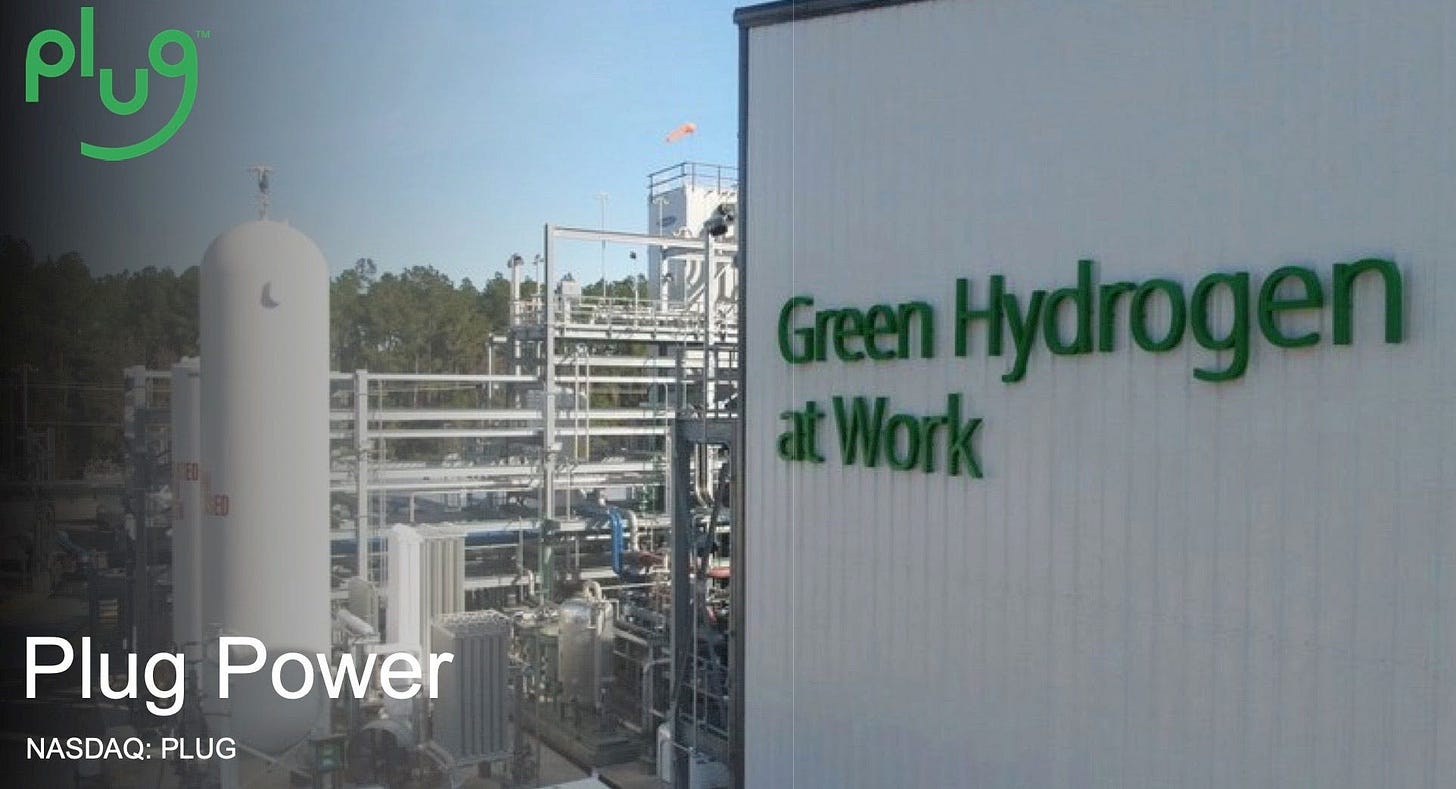“DOE Loan Office Defies Inspector General, Gives $7.2B In Loan Guarantees To Rivian & Plug Power” By ROBERT BRYCE
“The Loan Program Office gave loan guarantees to the two companies, which have lost more than $24 billion since 2021.”
DOE Loan Office Defies Inspector General, Gives $7.2B In Loan Guarantees To Rivian & Plug Power
The Loan Program Office gave loan guarantees to the two companies, which have lost more than $24 billion since 2021.
JAN 19
On December 17, the Department of Energy’s Inspector General issued a report urging the agency to halt all loans and loan guarantees from the Loans Program Office until it could ensure that it is complying with “conflicts of interest regulations and enforcing conflict of interest contractual obligations.”
Despite the IG’s request, on Thursday, the LPO gave loan guarantees worth $7.2 billion to EV maker Rivian and Plug Power, which calls itself the “industry leader behind the end-to-end green hydrogen ecosystem.” Rivian got a $6.57 billion guarantee, and Plug received a $1.66 billion guarantee.
The LPO, headed by Jigar Shah, replied to the IG’s report by saying that no conflicts of interest had been identified and that halting loans and loan guarantees was “baseless and vastly disproportionate.” The investigation into the LPO was instigated by Senator John Barrasso (R-WY), who was concerned about connections between Shah and Plug Power. Further, as Barrasso explained last June, he had “significant doubts about Plug Power’s financial viability.” Barrasso also said he was concerned that the “LPO may accelerate its lending in anticipation of a potential change in administration.”
Barrasso was right to be concerned about Plug. He should also be worried about Rivian’s financial viability. Indeed, the LPO gave loan guarantees to the two companies even though neither has ever made a profit. Both companies are losing staggering amounts of money. And both are competing in markets where production costs are high and demand is falling.
Further, the LPO did exactly what Barrasso feared. It handed out the two loan guarantees in the last few hours of the Biden administration. But then, maybe that’s not surprising. The Bidenistas have been promoting claims about a “robust clean energy economy” (that’s from the Plug press release) and a “clean transportation future” (that’s from the Rivian release) for four years. And thus, they are handing out as many government favors as possible on their way out the door.
But even last-minute government favors may not be enough to make Rivian and Plug profitable. Let’s take a look.
To receive all new articles, post comments, and support my work, please consider becoming a paid subscriber.
When it comes to losing money on EVs, Ford Motor Company has been a leader of the pack. As I noted on October 28, Ford lost $58,391 for each EV it sold during the third quarter of 2024. During that quarter, Ford sold 20,962 vehicles and its EV-related losses totaled $1.22 billion.

But Rivian is leaving Ford in the dust. In the third quarter, Rivian delivered 10,018 vehicles and recorded an operating loss (EBITDA) of $757 million. Thus, Rivian is losing about $75,563 for every EV it sells. Furthermore, the company is burning through stunning amounts of cash. During the first three quarters of 2024, it recorded a net loss of $4 billion.
Even more remarkable: Since 2021, Rivian has lost $20.8 billion. And the company’s future looks shaky. In its third-quarter report, the company noted that it has about $6.7 billion in cash, but it also identified a myriad of challenges, including what it calls “known and unknown risks.” Among the many issues it faces, Rivian says:
We will require additional financing and capital to support our business; our ability to maintain strong demand for our vehicles and attract and retain a large number of customers; risks relating to the highly competitive automotive market, including competitors that may take steps to compete more effectively against us, including with respect to pricing and features, and impact of competition and macroeconomic conditions on product demand; consumers’ willingness to adopt electric vehicles;
Let’s consider that “strong demand” issue. On January 16, the same day the LPO announced the Rivian deal, Reuters reported that another pure-play EV company, Polestar, would take longer to reach profitability due to “declining EV demand and intensifying competition from manufacturers such as Tesla and Volkswagen.” Polestar provides a good comparison to Rivian because the two companies produce about the same number of EVs. During the third quarter it sold 12,548 vehicles.
Other automakers are also slowing their EV rollouts due to sluggish demand. As I reported in October, major automakers:
Including VW, Ford, GM, and Mercedes have delayed their EV plans or slashed planned output due to weak sales. Morningstar noted that while some automakers, including Ford, have cut prices, that has hurt their profitability. It also says that with EV sales “to early adopters now seemingly exhausted, EVs are struggling to maintain ongoing sales momentum among mainstream consumers.”
Speaking of sales momentum, Canoo doesn’t have any. On Friday, the day after the LPO announced the Rivian loan guarantee, EV maker Canoo filed for Chapter 7 bankruptcy. Like Rivian, Canoo had loads of hype. The company, which had manufacturing capacity in Oklahoma, had a slew of high-profile agreements with outfits like the US Postal Service, NASA, and the Department of Defense. In a statement on the bankruptcy, Canoo CEO Tony Aquila thanked the company’s employees for their “dedication and hard work.”
Aquila deserves a plaque on the Wall of Shame for privileged CEOs. As I noted last month, Aquila billed the company for about $3 million over the past three years to pay for his travel around the country in private jets. In 2023, Canoo spent $1.7 million reimbursing Aquila’s company for his private jet travel. That was roughly double the revenue that Canoo generated that year.
Now, let’s look at Plug Power, a company that, like Rivian, is losing stunning sums of money.
In the third quarter of 2024, the company lost $211.1 million on revenue of $173.7 million. Furthermore, the company’s revenues are falling. During the first three quarters of 2023, Plug’s revenues totaled $669 million, and losses totaled $726.4 million. During the first three quarters of 2024, the revenues fell to $437.3 million, but losses totaled $769.3 million. Those are troubling numbers. Making matters worse: At the end of the third quarter, the company only had about $94 million in cash.
In all, Plug’s losses total $3.3 billion since 2021 and those losses are likely to continue for the foreseeable future.

Context here is essential. As I reported in mid-October in “The Hydrogen Bust Is Here,” companies all over the world are canceling or delaying planned projects. Why? The entire notion of “green” hydrogen is a fool’s errand. As Steve Brick has memorably put it, hydrogen is a “thermodynamic obscenity.” As I explained, it takes about three units of energy, in the form of electricity, to produce two units of hydrogen energy. In short, getting to Plug’s “green hydrogen economy” requires scads of super-cheap electricity (a high-quality form of energy) to make a tiny molecule that’s hard to handle, difficult to store, and expensive to use. In that October piece, I cited a study done by researchers at Harvard which found:
“Even if production costs decrease in line with predictions, storage and distribution costs will prevent hydrogen from being cost competitive in many sectors.” That’s the money quote from Roxana Shafiee, a postdoctoral fellow at Harvard University’s Center for the Environment, who led the study. Shafiee continued, saying, “Our results challenge a growing idea that hydrogen will be the ‘Swiss army knife of decarbonization’ and suggest that the opportunities for hydrogen may be narrower than previously thought.” The punchline of the report is stunning, “At current delivered prices, green hydrogen is a prohibitively expensive abatement strategy, with carbon abatement costs of $500–1,250 per ton of CO2 across sectors.”
My October article listed eight hydrogen projects that have been canceled or abandoned over the past few months. Since then, more deals have been scuttled, including three projects in Spain that were to be built by Repsol. Last month, Westwood Global Energy reported that 23 hydrogen projects in Europe had been “canceled or stalled” due to high costs, as well as “failure to obtain funding, and lack of demand.”
Furthermore, on January 16, the same day the LPO announced the loan guarantee to Plug, the DOE released a report that underscored the hydrogen sector’s many problems. It said that over the past 22 months, production costs for hydrogen “have increased from $3-6 per kilogram to $5-7 per kilogram.” The same report notes that while projects with a total hydrogen production capacity of some 17 million tons per year have been announced, “project delays and cancellations may reduce operational production capacity” to between 7 and 9 million tons per year. In other words, costs are increasing and output projections are falling. Those are hardly the ingredients needed to make Plug a success.
A final point, and it’s one the incoming Trump administration should investigate: If Plug was a good bet, why did the LPO wait so long to approve the loan guarantee? In its January 16 press release, the LPO disclosed that “Plug submitted its application to LPO in November 2020.” Thus, it took the LPO 50 months to determine if Plug was a good risk. Really? 50 months? And yet, the LPO could only reach a favorable decision four days before Biden leaves office?
That’s some coincidence.
The facts here are apparent: the LPO rushed to approve the loan guarantees to Plug and Rivian despite their lousy financial conditions and shaky business prospects.
It remains to be seen how much these deals will cost US taxpayers. And who knows? Maybe Plug and Rivian will surprise everyone, suddenly become viable businesses, and begin throwing off huge “clean” profits.
But I wouldn’t bet on it.










Apparently not enough so called energy experts know about Heliogen Or Sun Hydrogen. Another "coincidence"?